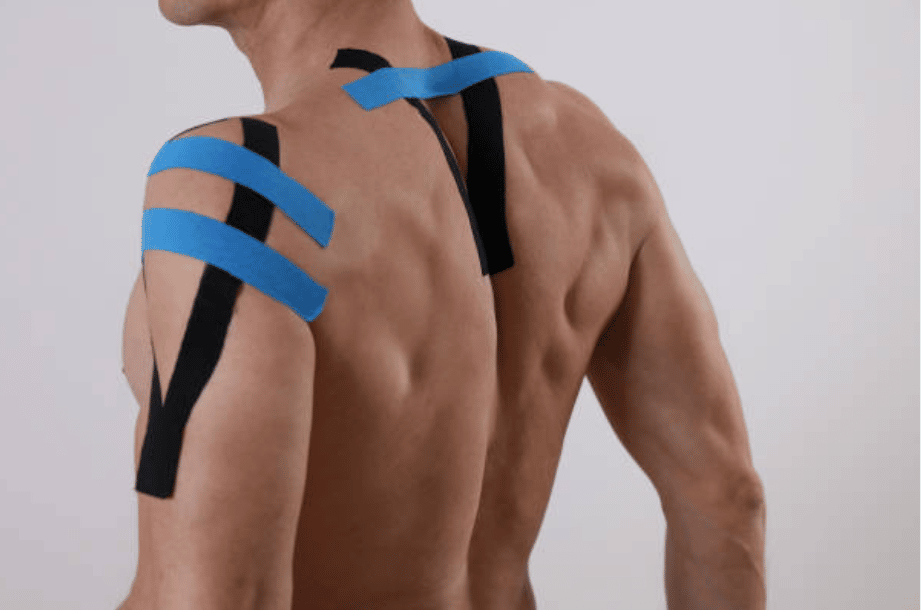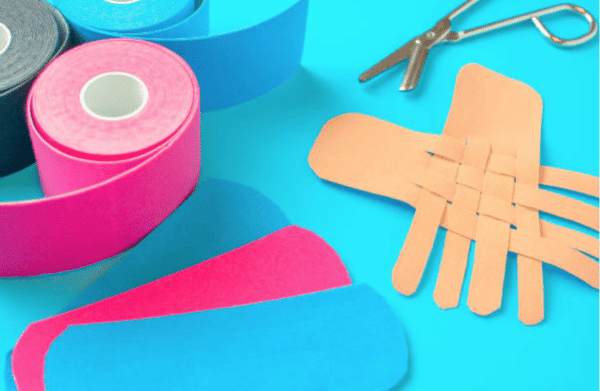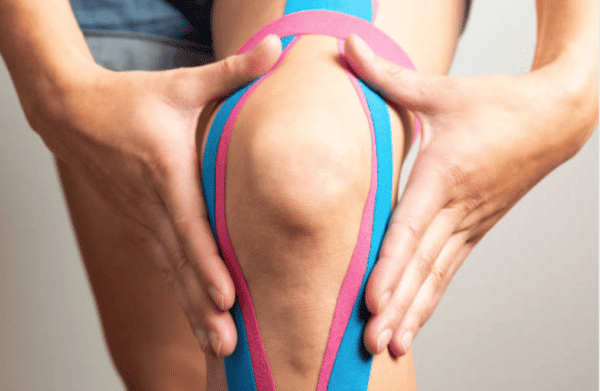Do you feel pain in your wrist, knee or neck drainage? K-taping can immobilize and heal joint pain. Find out more about the relief provided by this therapeutic tape treatment, which is in great demand in the world of sports.
What are the different ranges of K tape?
Kinesiology enthusiasts will be pleased to learn that there are several adhesive drainage strips on the market. The tape can be installed in different ways, the objective being that it fits to the anatomy of the muscle (or neck) and remains parallel to the muscle fibres. The colour only has a relaxing or stimulating effect. The k tape is used only once in case of trauma to the skin area. However, precautions must be taken when applying these tapes to a person with fragile skin, as there is a risk of irritating the trauma area. The bandage immobilizes the knee and joints, forcing them to remain in a resting posture. With k-taping, muscle fibres and tendonitis take less time to heal.
The beige and pink bands have a toning effect. The blue and black bands have a relaxing effect.
The direction of the band determines the action of the band: the toning effect is obtained by deploying the band in the direction of muscle contraction (from the muscle towards the end). In the opposite direction, from the end of the muscle towards the origin, it is a relaxing action.
Depending on the objectives to be achieved, it is easy to choose the type of kinesiology bandage: sprain, hematoma, ligament... The bandage is done according to the tension of the bandage and the direction, some kinesiologists combine different techniques.
Who are they for?
K-taping joints are available to everyone. Whether you are a child, an adult, a pregnant woman, an athlete or a bodybuilder, elastic bands relieve muscular aches and pains and can heal ligament and joint injuries. Very appreciated by physiotherapists, k-taping joints are used in kinesiology. Nevertheless, there are supplements to take when you want to strengthen the joints such as shark cartilage for example.
What are their benefits?
Kinesiotaping is a self-adhesive tape with excellent stimulation properties. These stimulation tapes are permeable to steam and air and do not absorb water. They are convenient for showering with. Once the strip has been properly attached, you can keep it on for several days and continue to treat yourself. Count on up to 5 days for optimal performance, beyond that performance decreases. In order to avoid any trauma, it is not advisable to apply the adhesive strips less than 2 hours before a sports session.
Why use the K tape?
The k-tape is a therapeutic method with multiple virtues and diverse functionalities, with exceptional results. As an example of application, the neuromuscular taping can reduce tendon joint problems, treat sprains and inhibit a muscle or promote muscle contraction. In preventive mode, they help to avoid injuries. Thanks to this roller, you can optimize your training.
The application of the roll bands also activates the lymphatic and blood circulation. In fact, thanks to this method of application, one avoids contracting haematomas and oedemas, and improves the speed of recovery at the end of sports sessions for athletes. K-taping also tones the muscles so that they are more resistant to effort and more flexible.
For body-building practitioners as well as high-level athletes, taping is the therapeutic lever par excellence for preparation, training and prevention.
The skin epidermis lifts slightly due to the glue and tension from the band. This is a very effective and natural technique for overcoming the main skin problems, especially the reduction of tension in the ligaments, tendons or wrists.
It is important to note that using neuromuscular taping does not absolve you of the need for the additional care required for each ailment. The tape just helps to limit the pain, but does not eliminate the cause. It helps you not to interrupt sports activities. It is therefore a temporary treatment. Moreover, it should be remembered that they do not exempt you from doing a good warm-up before you train.
If you want to build up your muscles properly, use a sports coach will allow you to reach your goals more quickly, while avoiding any risk of injury.
How do I put the coloured bands in place?
The best solution is to have a physiotherapist apply the k-taping adhesive strips. There are several techniques used to apply the relief tapes. Some techniques are more complex than others. Here are the main methods of correction: space, lymphatic, functional, tendon, fascia, mechanical and muscular correction.
The k tape is suitable for use in case of muscle contraction on one of the quadriceps. After a physiotherapy session, some people decide to apply the k-taping elastic bands in inhibition on the muscle. Remember, however, that the area to be treated with the tape must be properly waxed, as the purpose is to strengthen the adhesion of the tape. The skin must of course be dry, so no creams or oils should be used to help the tape adhere perfectly. Avoid placing the k-tape on a wound. The tape should be removed gently, following the direction of the hair.
Some practical examples that require the application of the tape: patellar tendonitis (the mechanoreceptive tape is applied to obtain an analgesic action) and torticollis (following an osteopathic correction, the application of a mechanoreceptive tape in inhibition not far from the muscle in question is authorised). With k-taping, its preventive side is less restrictive and relieves you of many ailments.
Are they really effective for bodybuilding injuries?
Kinesiology is used more in the sports field to complete or prolong the action of a medical treatment at the end of a physiotherapy or osteopathic correction session. These strips are also designed to soothe muscle contractions.
It is therefore easy to understand the importance of the skill of the person who is going to apply the k-taping tape; he must know the contraindications and indications of each method. The physiotherapist must master the direction, the shape, but above all the correct dosage of the tension of the tape in contact with the skin. More and more physiotherapists are being trained to master the application of the k-tape and to ensure that patients receive quality treatment. It is therefore essential to follow the recommendations in the guide or to call on a professional to apply them correctly.
You can find these tapes here: K tape roll blue or ask your pharmacist.
Conclusion
Much more used in sports and bodybuilding, kinesiology is a therapeutic method with many indications and features. Dr. Kenzo Kaze, a Japanese chiropractor, who invented it in the 1970s. This technique helped him to relieve benign muscular pains by ensuring the continuity of human movements. As material, a cotton k-tape containing adhesive glue to hold it to the skin. The tape contains no latex or active ingredients and is stretchable. After years of research and development, this method is in full expansion.
Other articles to read :
Should you continue to exercise over the aches and pains?
Tiger Balm in bodybuilding: useful or not?
How to use the massage roller as a complement to weight training?










